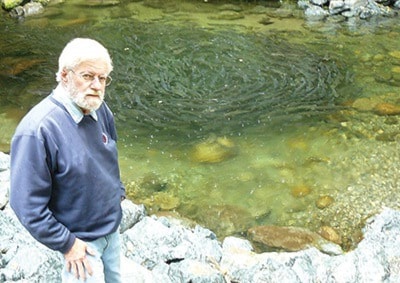There was a time when you could practically walk across Nile Creek on the backs of spawning pink salmon. There was also a time — not that long ago — when the watercourse was nearly devoid of fish.
Thanks to Ken Kirkby and the Nile Creek Enhancement Society though, the creek is once again near — or even beyond — its original abundance.
Taking a stoll along the banks of the creek on Thursday, Kirkby points to a swirl of pink salmon crowding each other out in a back eddy.
"This is just a tiny fraction," he said. "The whole creek is like this for five kilometres. The numbers are staggering."
Kirkby said this is the sixth year in a row when the number of pink salmon migrating upstream to spawn in the Qualicum Bay-area creek has jumped dramatically.
There's vastly more this year," he said. "We had about 100,000 last year and all we can say this year is that there's a lot more."
That's good news for the pink salmon, but also good news for other fish species, bears, eagles and the local economy.
"This is the reason the coho are coming back in big numbers," he said. "The carcasses are conveyor belts that bring phosphorous and nitrogen into the river. Otherwise, the river is barren. Coho need the food that these carcasses produce. Now, the river is full to the gills with coho fry and smolts. As well, the cutthroat trout we thought we had lost forever are coming back."
In order to spread the wealth around, members of the Nile Creek Enhancement Society make a point of spreading the carcasses of the spawned-out fish into the riparian area next to the river.
“If there’s a big freshet and the fish are still in the creek, they can be washed away, but if they’re on the bank, the nutrients percolate in slowly,” Kirkby said. “They become the fertilizer department for the river.”
The result, he said, goes beyond just a healthy salmon run. Local area businesses are booming thanks to the many fishers who swarm to the area to set a hook in the abundance. Each of them, he added, spends a significant amount of money in the area.
“They all eat, they all get rooms,” he said.
The reason for this year’s abundance undoubtedly has a great deal to do with the long hours and indeed years of work done by the society to improve the creek’s habitat. However, the run also mirrors other areas, which are also seeing strong returns this fall.
“It’s a combination of many factors, some of which we know, some we don’t,” he said. “Conditions in the ocean must have been ideal, because pink salmon are thriving. They stopped counting at 50 million in Alaska.”
The vast majority of the work on Nile Creek is now completed, although the pink salmon hatchery continues to supply fry to supplement the wild spawn. However, Kirkby said he’s not entirely convinced the entire project is finished.
“When is success achieved?” he asked. “How many runs do we need before nature says, Okay, enough? It took 50 years to destroy this river, so it might take that long to restore it.”
Kirkby’s next step will be to step away from the creek for a while to produce a book that details the steps taken by the society to bring Nile Creek back from the brink.
